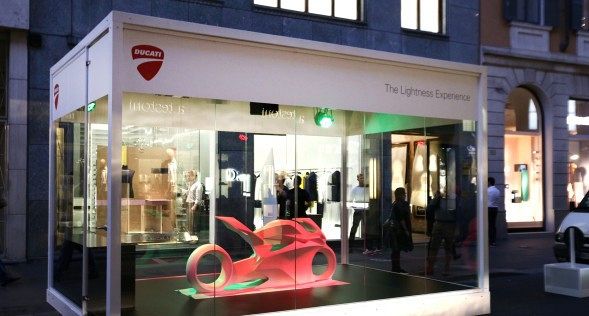Mottos seem to gain extra strength when they are in Latin. Just think of the United States Marine Corps’ “Semper Fidelis,” which means “always faithful.” Or the United States Coast Guard’s “Semper Paratus” which means “always ready.” And then, of course, there’s “E pluribus unum,” which means “out of many, one.” The moment you hear them, you immediately stand at attention.
In all its years, Ducati has never added a motto in Latin to its desmo badge. Now, however, it has: “Fortitudo mea in levitate.” Are you able to figure it out? It means “in lightness my strength.”
This is fascinating. To announce this motto and explain its intimate meanings, Ducati Design Director Andrea Ferraresi and Chief Designer GianAndrea Fabbro held a press conference at the Audi City Lab, located in the most celebrated high-fashion street in downtown Milan, the via Montenapoleone. Next time you watch The Devil Wears Prada, think of via Montenapoleone when you see the lineup of exclusive high-fashion shops: Prada, Valentino, Armani, the whole lot. Audi has established a headquarters there, for formal and informal meetings in a rarefied, elegant atmosphere of champagne, exclusive leathers and woods, plus an Audi R8 V-10.
Along the street, Audi has aligned a selection of Audi and Lamborghini models in glass boxes, plus a computer-generated motorcycle sculpture, carved in plastic by computer-driven grinders. It’s a pure design study from the Ducati style department, but reflective of the present design trend under Ferraresi and Fabbro.
I dealt with designers back in the old days, when I was at Ducati and the company most unfortunately hired the celebrated Giorgetto Giugiaro to design the 860 GT, which was a total flop. Since then, I’ve developed a mistrust toward pure designers involved in motorcycling. To make it very clear, anyone calling Massimo Tamburini a designer does not understand much about his supreme technical knowledge and capabilities, and his total passion for motorcycles and motorcycling. He never submitted functionality and performance to styling. And it was very pleasing hearing both Ferraresi and Fabbro share this same, fundamental approach.
“In Lightness My Strength” is firmly believed by all at Ducati, from CEO Claudio Domenicali down to every level in the chain of command. I particularly admire Andrea Forni, R&D Director, when he states that there is never a limit to lightness, and that the next bike must always be lighter than the previous one. Forni knows what he is talking about. He is still awfully fast at the racetrack, and he knows what being in perfect symbiosis with the bike means. And a key factor is lightness.
Ferraresi started working at Ducati Styling Department in late 1999 and his first task was updating the 916 into the 996. There, he learned a good lesson from the work of Tamburini—that creating components to accomplish two functions is a very sound and straightforward way to lightness, a path further developed by another great visionary of modern motorcycling design, Erik Buell. “That is a basic step, a concept that GianAndrea [Fabbro] and I we keep always firmly in mind when we start a new project. The 1199 is the epitome of this approach and of our never ending research for more essential and more rational styling solutions that do not need covers, plastic or chrome bands,” said Ferraresi.
Fabbro is the man behind the very successful 1199 design. “Interface with project engineers was all part of the process of development of the 1199 design,” said Fabbro. “We cooperated to make each solution both rigorously functional and aesthetically pleasant. The ultimate purpose is the realization of the ultimate superbike, Ducati style. The 1199 Superleggera is a distillate of our approach and our abilities. Lightness is a major factor of the ultimate potential of a sport bike, and sportiness is in Ducati DNA.”
Achieving lightness through essential design is a positive approach, but now it is time to experiment with new materials with great strength and extreme lightness. Ducati experimented with carbon fiber in the construction of the Desmosedici GP Racer frame, but then backed off of under pressure from Valentino Rossi’s pressure. Is Ducati having second thoughts about that?
“Carbon fiber is a fantastic material, as proven in aerospace applications. But its technology is still evolving,” said Ferraresi. “The present state of the art cannot be applied to mass production of motorcycles. Costs remain prohibitive. Even the automotive industry is taking a cautious approach.”
Motorcycles have grown bigger and heavier from the 1970s onward, and sometimes design seems to be responsible. “Not in our case, for sure,” stated Ferraresi. “It all comes from the new regulations, new safety and emissions standards. There we have not much to do. An ECU is a box of given size and given weight; a canister is a jug of a mandatory capacity, no shortcuts are possible there.”
Ferraresi also is an aerospace engineer, and he’ll know when exotic materials will become more accessible. The good thing about him and Fabbro is this: They are absolutely passionate about motorcycles and motorcycling, and they fully embrace “Fortitudo mea in levitate.”











24
Comment